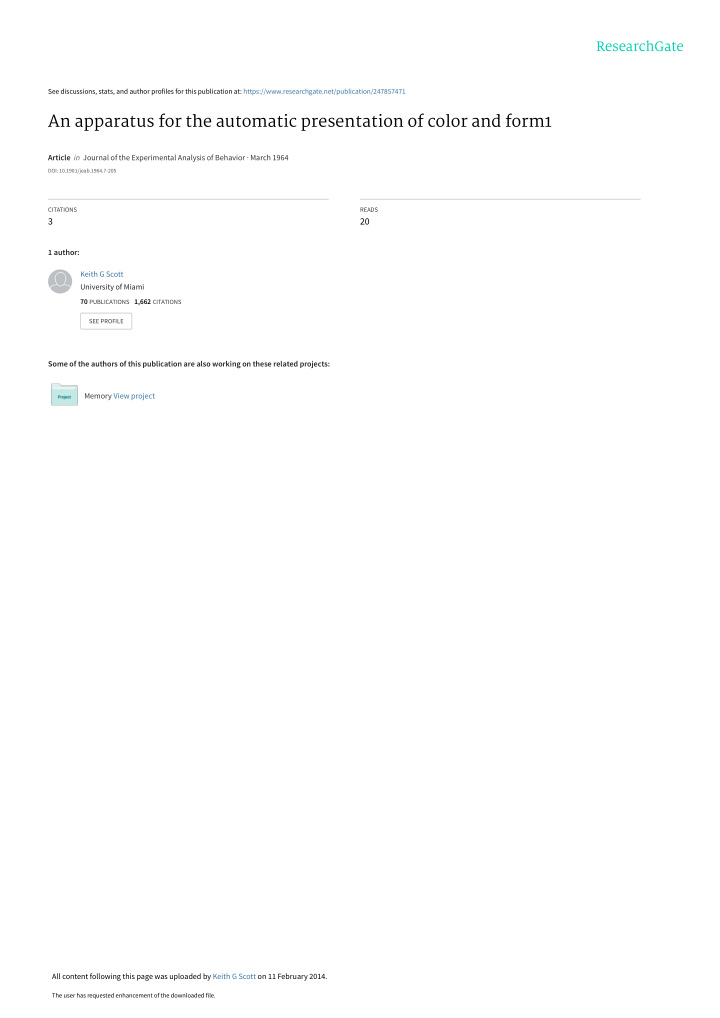



See discussions, stats, and author profiles for this publication at: https://www.researchgate.net/publication/247857471 An apparatus for the automatic presentation of color and form1 Article in Journal of the Experimental Analysis of Behavior · March 1964 DOI: 10.1901/jeab.1964.7-205 CITATIONS READS 3 20 1 author: Keith G Scott University of Miami 70 PUBLICATIONS 1,662 CITATIONS SEE PROFILE Some of the authors of this publication are also working on these related projects: Memory View project All content following this page was uploaded by Keith G Scott on 11 February 2014. The user has requested enhancement of the downloaded file.
1 964 VOLUME 7, NUMBER 2 MARCH, JOURNAL OF THE EXPERIMENTAL ANALYSIS OF BEHAVIOR AN APPARATUS FOR THE AUTOMATIC PRESENTATION OF COLOR AND FORM' KEITH G. ScoTT UNIVERSITY OF CONNECTICUT To study transfer effects in learning (e.g. combinations of two dimensions, such as House and Zeaman, 1963) it is often necessary color and form. Typically, stimuli have been to have available a large number of stimulus drawn on cards and presented in a Wisconsin General Test Apparatus. The present appara- tus was designed to provide the advantages 'This work was supported by Research Grant M-1099 from the National Institute of Mental Health, USPHS. of the more controlled operant situation. It The author wishes to thank Dr. David Zeaman and features separate control of colors and forms the staff of the University of Connecticut Shop for help so these may be automatically presented in any and advice. Mr. Frank Turrisi assisted with the wiring combination. Currently used with retarded of control equipment. Fig. 1. Photograph of one display unit dismounted and lying face downward to reveal the switch and position- ing mechanisms. On this right-hand member of the pair, the display cell is mounted to the left of the motor. 205
206 KEITH G. SCOTT ~~~~~~C children it should need little modification for CAM OPERATED SELECT SWITCHES MCROSWITCHES use with lower organisms. Figure 1 is a photograph of the mechanism of one display unit. Figure 2 is a schematic diagram. A motor, Slo-Syn SS250, cost $65.00, drives a pegged shaft and a grooved positioning cam with a spring loaded wheel running on it. The pegs engage with microswitches (Unimax, type 2HBW-1) as shown in the insert in Fig. 2. On the end of the shaft is a filter wheel with seven Wratten filters, in 35mm Airequipt 110 VAC slide mounts, clipped to its outer edge. One Fig. 3. Wiring diagram for a motor. Specifications of filter is always positioned exactly between R and C depend on the motor type used and are the plexiglas response key and the display cell. specified by the manufacturer. pushbutton switches, one bank for color and Posuitoning corn one bank for form, are used. Automatic selec- Insert tion is achieved with a punched tape pro- and wheel grammer (Scott, 1964). With a standard in-line display 36 stimuli, combining six colors and six forms, are avail- Microswitches able. Such stimuli appear as white illuminated figures on a colored circular ground. The present display provides 84 stimuli, combining Filtr wheel Motor 12 forms and seven colors. The stimuli appear as solid colored figures on a black background Pegged shalt and their saturation and brightness may be changed by inserting appropriate combina- Disply cell Response key tions of colored and neutral density filters. The 12 form stimuli on the display cells were made to special order for use with ~~Filter t0,_ children. The preparation costs of the special Respome switch stimuli for the type 1820 projectors with Fig. 2. Schematic diagram of a display unit showing 15/16 in. diameter stimuli were $80.00. The position of the components. The insert shows the unit cost from Industrial Electronic Engineers, method of engagement of the microswitches with the North Hollywood, California, is $21.50. pegged shaft. The units are made in a pair with the dis- The Slo-Syn SS50 motors, shown in Fig. 1, play cells mounted on opposite sides so the started unreliably until the flexible coupling response keys can be brought close together in was installed. The manufacturers, the Superior a two-choice situation. Reinforcement is de- Electric Company, Bristol, Connecticut, ad- livered by a Davis M and M dispenser. The vise that with the larger type SS250 motor display is mounted in a sound-deadened cu- a direct drive could be used, obviating the bicle with the control equipment in an ad- need for fine adjustment. All Slo-Syn motors joining room. Pilot studies over a summer have a start-stop time of 25 msecs and run at show the equipment to be completely reliable. 72 rpm giving a maximum change time be- tween filters of about .75 sec. REFERENCES The circuit used to operate the motors is House, Betty J. and Zeaman, D. Miniature experi- shown in Fig. 3. Only one select switch may ments in the discrimination learning of retardates. be closed at a time. It energizes the motor In, Lipsitt, L. P. and Spiker, C. C. (Eds.), Advances in child development and behavior. New York: through one microswitch which is opened by Academic Press, 1963, Pp. 313-374. a peg when the filter is correctly positioned. Scott, K. G. A programmer for discrimination learn- For manual stimulus selection, interlocking ing studies. J. exp. Anal. Behav., 1957, 7, 66. View publication stats View publication stats
Recommend
More recommend